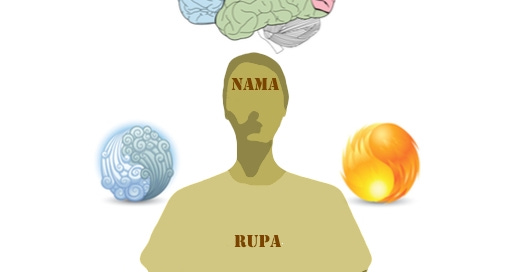In Buddhist philosophy, the term nāmarūpa (नामरूप ) represents one of the most fundamental concepts for understanding the nature of existence. It is a compound of two words: nāma ("name" or "mind") and rūpa ("form" or "matter"). Together, they signify the inseparable relationship between mental and physical phenomena.
The Meaning of Nama Rupa in Pali and Sanskrit
Nāma (नाम in Sanskrit and Pali) refers to the mental aspects of experience, including sensation (vedanā), perception (saññā), volition (saṁkhāra), and consciousness (viññāṁa). These are the components that process and interpret sensory input.
Rūpa (रूप in Sanskrit and Pali) refers to the physical aspect of existence, particularly the four great elements (mahābhūta): earth (paṁhavī), water (āpo), fire (tejo), and air (vāyo). These elements combine to form the material world, including the human body.
Nama Rupa in Buddhist Thought
Nama rupa is a crucial link in the twelve links of dependent origination (paṁicca-samuppāda), where it follows viññāṁa (consciousness) and precedes saṁāyatana (the six sense bases). According to this doctrine, nama rupa arises due to past karmic formations and, in turn, conditions the development of sensory experience.
In Buddhist terminology, nᾱma (mind) is not itself one of the five skandhas (pañcaskandha) but rather consists of four of the five aggregates:
Vedanā (वेदना / vedanā) – feeling or sensation
Saṃjñā (संज्ञा / saññā in Pali) – perception or recognition
Saṃskāra (संस्कार / saṅkhāra in Pali) – mental formations or volitional activities
Vijñāna (विज्ञान / viññāṇa in Pali) – consciousness
The fifth skandha, rūpa (form), is the physical aspect and corresponds to rūpa in nama-rupa.
So, nᾱma in nāmarūpa is effectively a composite of four skandhas, while rūpa is the fifth skandha.
The Non-Self (Anattā) Doctrine
This concept is central to understanding the non-self (anattā) doctrine. Neither mind (nāma) nor body (rūpa) has an independent existence; they depend on conditions and are impermanent (anicca). This insight is essential for progressing on the Buddhist path toward liberation.
Practical Implications of Nama Rupa
The distinction between nama and rūpa is not just a theoretical construct but has deep practical implications in meditation. Vipassanā (insight meditation) practitioners closely observe the interplay of nama and rūpa to realize their impermanence, suffering (dukkha), and non-self nature.
For example, when practicing mindfulness of breathing (anāpānasati), one may notice the physical sensation of the breath (rūpa) and the awareness of it (nāma). Recognizing this distinction can help disentangle the illusion of a permanent self and lead to deeper wisdom.
The teaching of nama rupa underscores the interdependence of mind and matter, helping practitioners move beyond the illusion of duality. Understanding this principle is essential for deepening one’s comprehension of the Buddhist path and achieving insight into the true nature of reality. By observing the workings of nama rupa in our daily lives, we can cultivate mindfulness and wisdom, ultimately leading to liberation from suffering.





